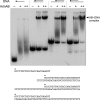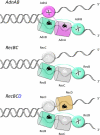Characterization of the mycobacterial AdnAB DNA motor provides insights into the evolution of bacterial motor-nuclease machines
- PMID: 19920138
- PMCID: PMC2807320
- DOI: 10.1074/jbc.M109.076133
Characterization of the mycobacterial AdnAB DNA motor provides insights into the evolution of bacterial motor-nuclease machines
Abstract
Mycobacterial AdnAB exemplifies a family of heterodimeric motor-nucleases involved in processing DNA double strand breaks (DSBs). The AdnA and AdnB subunits are each composed of an N-terminal UvrD-like motor domain and a C-terminal RecB-like nuclease module. Here we conducted a biochemical characterization of the AdnAB motor, using a nuclease-inactivated heterodimer. AdnAB is a vigorous single strand DNA (ssDNA)-dependent ATPase (k(cat) 415 s(-1)), and the affinity of the motor for the ssDNA cofactor increases 140-fold as DNA length is extended from 12 to 44 nucleotides. Using a streptavidin displacement assay, we demonstrate that AdnAB is a 3' --> 5' translocase on ssDNA. AdnAB binds stably to DSB ends. In the presence of ATP, the motor unwinds the DNA duplex without requiring an ssDNA loading strand. We integrate these findings into a model of DSB unwinding in which the "leading" AdnB and "lagging" AdnA motor domains track in tandem, 3' to 5', along the same DNA single strand. This contrasts with RecBCD, in which the RecB and RecD motors track in parallel along the two separated DNA single strands. The effects of 5' and 3' terminal obstacles on ssDNA cleavage by wild-type AdnAB suggest that the AdnA nuclease receives and processes the displaced 5' strand, while the AdnB nuclease cleaves the displaced 3' strand. We present evidence that the distinctive "molecular ruler" function of the ATP-dependent single strand DNase, whereby AdnAB measures the distance from the 5'-end to the sites of incision, reflects directional pumping of the ssDNA through the AdnAB motor into the AdnB nuclease. These and other findings suggest a scenario for the descent of the RecBCD- and AddAB-type DSB-processing machines from an ancestral AdnAB-like enzyme.
Figures








Similar articles
-
Double strand break unwinding and resection by the mycobacterial helicase-nuclease AdnAB in the presence of single strand DNA-binding protein (SSB).J Biol Chem. 2010 Nov 5;285(45):34319-29. doi: 10.1074/jbc.M110.162925. Epub 2010 Aug 23. J Biol Chem. 2010. PMID: 20736178 Free PMC article.
-
AdnAB: a new DSB-resecting motor-nuclease from mycobacteria.Genes Dev. 2009 Jun 15;23(12):1423-37. doi: 10.1101/gad.1805709. Epub 2009 May 26. Genes Dev. 2009. PMID: 19470566 Free PMC article.
-
Homologous recombination mediated by the mycobacterial AdnAB helicase without end resection by the AdnAB nucleases.Nucleic Acids Res. 2017 Jan 25;45(2):762-774. doi: 10.1093/nar/gkw1130. Epub 2016 Nov 29. Nucleic Acids Res. 2017. PMID: 27899634 Free PMC article.
-
Bacterial DNA repair: recent insights into the mechanism of RecBCD, AddAB and AdnAB.Nat Rev Microbiol. 2013 Jan;11(1):9-13. doi: 10.1038/nrmicro2917. Epub 2012 Dec 3. Nat Rev Microbiol. 2013. PMID: 23202527 Review.
-
How Does a Helicase Unwind DNA? Insights from RecBCD Helicase.Bioessays. 2018 Jun;40(6):e1800009. doi: 10.1002/bies.201800009. Epub 2018 Mar 30. Bioessays. 2018. PMID: 29603305 Free PMC article. Review.
Cited by
-
Structure-activity relationships at a nucleobase-stacking tryptophan required for chemomechanical coupling in the DNA resecting motor-nuclease AdnAB.Nucleic Acids Res. 2022 Jan 25;50(2):952-961. doi: 10.1093/nar/gkab1270. Nucleic Acids Res. 2022. PMID: 34967418 Free PMC article.
-
Characterization of three mycobacterial DinB (DNA polymerase IV) paralogs highlights DinB2 as naturally adept at ribonucleotide incorporation.Nucleic Acids Res. 2014;42(17):11056-70. doi: 10.1093/nar/gku752. Epub 2014 Sep 8. Nucleic Acids Res. 2014. PMID: 25200080 Free PMC article.
-
The AddAB helicase-nuclease catalyses rapid and processive DNA unwinding using a single Superfamily 1A motor domain.Nucleic Acids Res. 2011 Mar;39(6):2271-85. doi: 10.1093/nar/gkq1124. Epub 2010 Nov 10. Nucleic Acids Res. 2011. PMID: 21071401 Free PMC article.
-
Escherichia coli RecBC helicase has two translocase activities controlled by a single ATPase motor.Nat Struct Mol Biol. 2010 Oct;17(10):1210-7. doi: 10.1038/nsmb.1901. Epub 2010 Sep 19. Nat Struct Mol Biol. 2010. PMID: 20852646 Free PMC article.
-
Insights into Chi recognition from the structure of an AddAB-type helicase-nuclease complex.EMBO J. 2012 Mar 21;31(6):1568-78. doi: 10.1038/emboj.2012.9. Epub 2012 Feb 3. EMBO J. 2012. PMID: 22307084 Free PMC article.
References
Publication types
MeSH terms
Substances
Grants and funding
LinkOut - more resources
Full Text Sources
Miscellaneous

